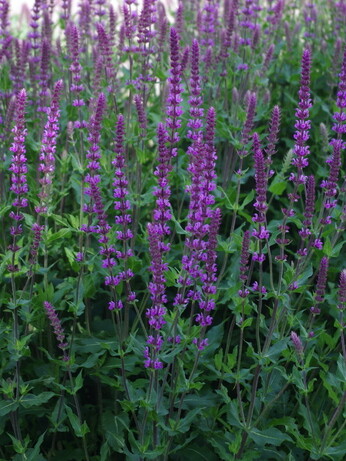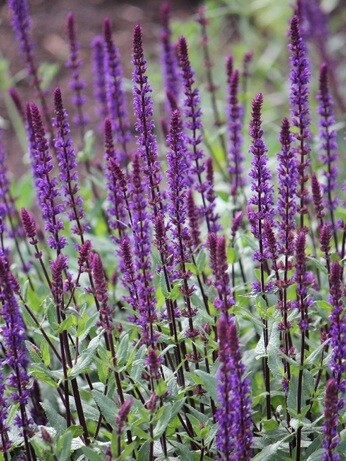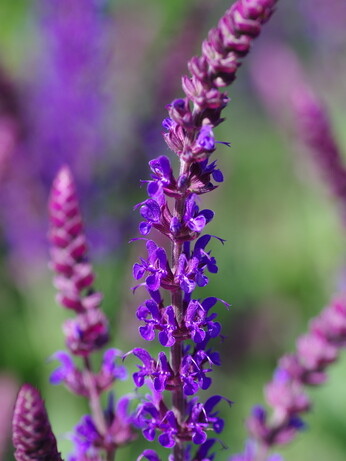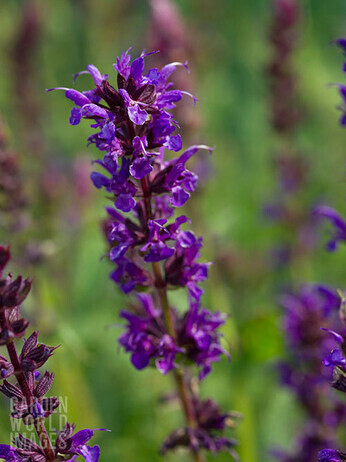Find out what the propagation and garden teams have been up to this week.

Salvia nemorosa- how to grow and care for

The species name- nemorosa (‘of woods’) refers to the natural habitat of this salvia, typically found growing in groves and woods across central Europe and Western Asia, however aromatic compounds in leaves act as a sunscreen, allowing plants to thrive in sunny situations.
A favourite of many for its unrivalled, intense flowers adding splashes of colour in the garden. Popular cultivars propagated and sold at Beth's include Salvia nemorosa ‘Caradonna’, S. ‘Ostfriesland’, S. ‘Amethyst’ and S. ‘Wesuwe’, each producing summer-long displays of strong, violet-blue flower spikes.
Salvia nemorosa cultivars are tolerant of most soil conditions, however, they don’t like sitting in wet soil over winter, so ensure the soil is free draining to avoid rot. A full sun position (receiving at least 6 hours of sunshine in midsummer) is ideal.
Contrasting planting companions include Origanum vulgare ‘Thumble’s Variety’ with its fresh yellow-green leaves, Knautia macedonica with pin cushion, crimson flowers matching the salvias intense colour and Echinacea purpurea ‘Alba’ with its contrasting colour and flower shape.

Flowers are highly attractive to bees and butterflies and the long flowering period provides a supply of pollen and nectar from early summer through to early autumn. Our Bees, Bugs and Butterflies Collection includes salvia for this reason.
Irrespective of growth form, stature or location, any salvia in flower will be a busy, buzzy melée of insect activity. Bilaterally symmetrical flowers restrict the range of pollinators to primarily bees, especially bumblebees, the size of which reflects the size of the flowers in each species. In the Americas, hummingbirds are known to pollinate some of the species with longer petal-tubes. In addition, several species of micromoths use forms of salvia as their larval food plant. In the autumn, the seed-heads are attractive in their own right, and contain seeds that are food for finches such as goldfinches, while the seed-heads also provide shelter for beneficial predators such as ladybirds, as well as smaller insects and spiders that may be gleaned by wrens.
Once flowers have faded in midsummer, the spent flower spikes can be removed to encourage a second flush of smaller flowers.
In late winter/early spring, last years spent plant material can be cut down to the ground ready for the new growth to emerge from the crown. For more information about how to cut back herbaceous perennials ready for the beginning of the growing season, click HERE.
Our range of Salvia nemorosa:
Salvia nemorosa ‘Amethyst’- slender spires of pink-purple flowers appear from early summer through into autumn rising from clumps of aromatic, mid-green leaves. Stands 70cm tall with a spread of 40cm.

Salvia nemorosa ‘Caradonna’- a superb new introduction with distinctly dark stained stems of violet blue flowers and much more upright in profile than other S.nemorosa. Shorter growing and will repeat flower if cut down after first flowering. Plants reach 50cm height and 30cm wide.

Salvia nemorosa ‘Ostfriesland’- purplish stems covered with pink-purple bracts and violet flowers. A robust and long lived, lower growing, perennial. Reaches a height and spread of 50cm.

Salvia nemorosa ‘Wesuwe’- selected form producing many spires of intense violet-purple flowers accented with dark red bracts creating interest for weeks. Plants grow to 60cm in height with a spread of 40cm.

Also meaning ‘of woodland’ is the closely related species S. x sylvestris which requires the same growing conditions and offers the same intense colours. Click here to find out more.


COMMENTS